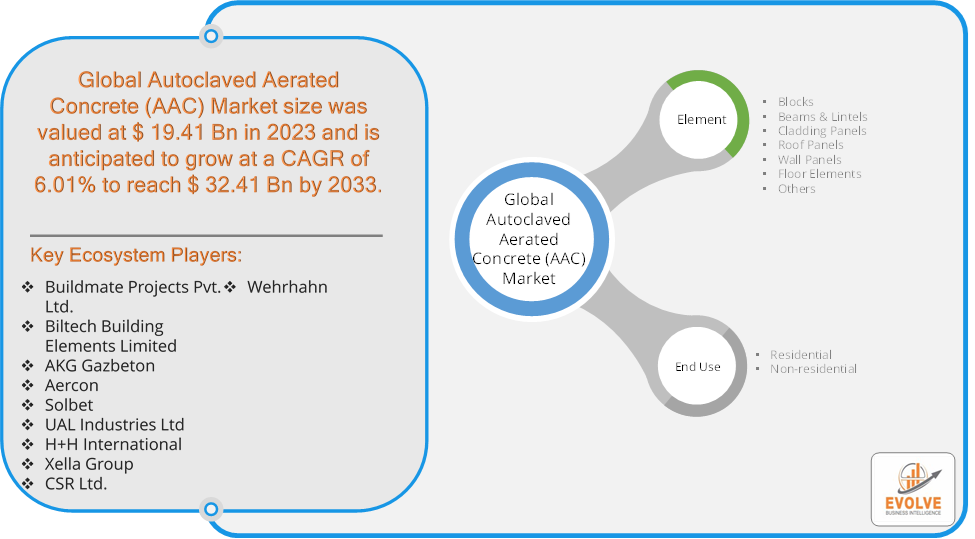AAC Market Grows: 6.01% CAGR Forecast

Evolve Business Intelligence has published a research report on the Global Autoclaved Aerated Concrete (AAC) Market, 2023–2033. The global Autoclaved Aerated Concrete (AAC) Market is projected to exhibit a CAGR of around 6.01% during the forecast period of 2023 to 2033.
Evolve Business Intelligence has recognized the following companies as the key players in the global Autoclaved Aerated Concrete (AAC) Market: Buildmate Projects Pvt. Ltd., Biltech Building Elements Limited, AKG Gazbeton, Aercon, Solbet, UAL Industries Ltd, H+H International, Xella Group, CSR Ltd. And Wehrhahn.
 More Information: https://evolvebi.com/report/autoclaved-aerated-concrete-aac-market-analysis/
More Information: https://evolvebi.com/report/autoclaved-aerated-concrete-aac-market-analysis/
Market Highlights
The Global Autoclaved Aerated Concrete (AAC) Market is projected to be valued at USD 32.41 Billion by 2033, recording a CAGR of around 6.01% during the forecast period. The Autoclaved Aerated Concrete (AAC) Market refers to the global industry involved in the production, distribution, and sale of autoclaved aerated concrete, a lightweight, precast, foam concrete building material. AAC is known for its high insulation properties, sound absorption, and ease of installation, making it popular in the construction industry for residential, commercial, and industrial buildings.
Factors driving the AAC market growth include increasing demand for sustainable construction materials, urbanization, energy efficiency regulations, and advancements in building technologies. Challenges may include the high initial costs of AAC production and competition from other lightweight construction materials.
The COVID-19 pandemic had a significant impact on the Autoclaved Aerated Concrete (AAC) Market. The pandemic led to global supply chain disruptions due to lockdowns, travel restrictions, and factory shutdowns. This affected the availability of raw materials and components needed for AAC production. Many construction projects were halted or delayed as a result of COVID-19, leading to decreased demand for AAC. Labor shortages, social distancing measures, and safety concerns further contributed to these delays. Health concerns and restrictions limited the number of workers on construction sites and in manufacturing plants, reducing productivity and slowing down AAC production and construction activities. The pandemic highlighted the importance of health and safety in buildings. AAC’s properties, such as mold resistance and better indoor air quality, gained attention, potentially driving future demand. The push for sustainable and energy-efficient construction increased during the pandemic, with AAC being a preferred material due to its environmental benefits, such as lower energy consumption and reduced carbon footprint.
Segmental Analysis
The global Autoclaved Aerated Concrete (AAC) Market has been segmented based on Element and End Use.
Based on Element, the Autoclaved Aerated Concrete (AAC) Market is segmented into Blocks, Beams & Lintels, Cladding Panels, Roof Panels, Wall Panels, Floor Elements and Others. The Blocks segment is anticipated to dominate the market.
Based on End Use, the global Autoclaved Aerated Concrete (AAC) Market has been divided into Residential and Non-residential. The Residential segment is anticipated to dominate the market.
More Information: https://evolvebi.com/report/autoclaved-aerated-concrete-aac-market-analysis/
Regional Analysis
The Autoclaved Aerated Concrete (AAC) Market is divided into five regions: North America, Europe, Asia-Pacific, South America, and the Middle East, & Africa. In North America, the demand for AAC is driven by the increasing focus on sustainable construction practices, stringent building codes, and the need for energy-efficient buildings. The United States and Canada are the primary markets. The adoption of green building certifications and energy-efficient regulations support AAC market growth in these countries. Europe has a well-established AAC market due to the region’s strong emphasis on sustainability, energy efficiency, and stringent environmental regulations. The EU’s focus on reducing carbon emissions and promoting green construction practices provides a favorable environment for AAC growth. Rapid urbanization, infrastructure development, and government initiatives promoting affordable housing are key drivers in the Asia-Pacific region. China, India, Japan, and Southeast Asian countries are major markets. China and India, with their massive construction activities and growing middle class, present significant opportunities. The demand for AAC in Latin America is driven by urbanization, infrastructure development, and the need for cost-effective and sustainable building materials. Brazil and Mexico are the leading markets in this region. Government initiatives aimed at improving housing conditions also support AAC adoption. In the Middle East and Africa, the growing construction sector, urbanization, and the need for energy-efficient buildings drive the demand for AAC. The UAE, Saudi Arabia, and South Africa are significant markets. The UAE and Saudi Arabia, in particular, are investing heavily in sustainable construction projects.


